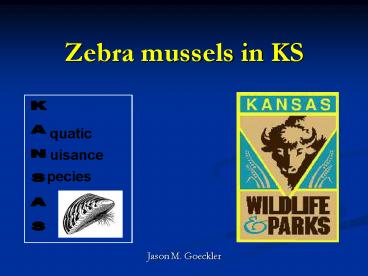Zebra mussels in KS - PowerPoint PPT Presentation
1 / 30
Title:
Zebra mussels in KS
Description:
Zebra mussels are native to the Black and Caspian Sea in Europe. ... Zebra mussels are established in El Dorado Reservoir, the Walnut River, Winfield ... – PowerPoint PPT presentation
Number of Views:75
Avg rating:3.0/5.0
Title: Zebra mussels in KS
1
Zebra mussels in KS
quatic
uisance
KANSAS
pecies
- Jason M. Goeckler
2
Zebra mussels are native to the Black and Caspian
Sea in Europe.
Native range
3
Arrived into the Great Lakes in 1988 in the
ballast water of ships.
4
Zebra mussels are established in El Dorado
Reservoir, the Walnut River, Winfield City Lake,
Cheney and Perry Reservoirs.
Regionally Lake of the Ozarks,
Taneycomo, MO Base Lake, NE Grand Lake,
Keystone, Kaw, Oologah, OK.
5
Why are ZM a problem?
- 700,000/m2
- Clog intake pipes
- Clogs trash screens
- Encrusts docks, buoys, ramps, rocksanything left
in the water
6
(No Transcript)
7
Recreational problems
- Very sharp shells
- Shells form windrows along shoreline
- Odor
- Can be transported easily
8
(No Transcript)
9
Fish and Wildlife Problems
- Habitat/spawning area degradation
- Filter feeders- up to a liter a day.
- Reductions in density and biomass of the
zooplankton community may result in reduced
growth or abundance of age-0 fish - Increase in algal blooms
- Bioaccumulation of toxins
- Nationwide expenditures-3.1 billion over 10
years.
10
What are zebra mussels
11
Adults
- 6 to 45 mm
- live to be 2-3 years old
- Sexually mature at 8mm
- Filter feed
- Firmly attach with byssal threads
12
Requirements
- Calcium levels 28-109 mg/L (ELDR 65mg/L)
- Water Temperatures 0-930F
- pH 7.4-9.3 (ELDR 8.25)
- DO 4.2-13.3 mg/L (ELDR 7.44mg/L)
- Settlement velocity
- Habitat abundant on hard surfaces and plants
- Berkman et al. (1998) have provided evidence that
zebra mussels can directly colonize sand
particles smaller than 1 mm and then use their
byssal threads to bind sediments into
conglomerates.
13
El Dorado Timeline
- 2001 infestation
- Fall 2003 discovery 50/m2
- December 2003 3½ foot lake drawdown
- 135/m2 in dry area
- Fall 2004 sample 25,178/m2
14
Veligers
- Spawning normally begins at 540F
- annually produce over 1 million eggs or 10
billion sperm - Microscopic, free floating
15
(No Transcript)
16
(No Transcript)
17
(No Transcript)
18
Veligers
19
- July 2005
20
How do you kill them?
- Manual Removal (powerwash, scraping)
- Chemical (Chlorine, Potassium, Al sulfate, Ozone,
starch?) - Thermal shock, dewatering, flushing
- Oxygen Deprivation
- Desiccation
- Summer (5 days min.)
- Winter (48 hr at -29 F)
- Biobullets
21
Chemical Treatment
- 12 Ac. Virginia Lake
- 131,000 kilograms Potassium Chloride
- 330/Ac. ft
- 50,160,000
22
Risk Assessment
- Surveyed recreational boaters 1998-2005
- 981 of 11,789 boaters visited El Dorado or
Oologah, OK - El Dorado visitors traveled between 10-1562 miles
mean distance of 112 mi. - Winfield City Lake identified as 9 at risk lake.
- Cheney Reservoir identified as 1 at risk lake.
- Perry didnt make the list.
From D.K. Britton and R.F. McMahon 2006
23
(No Transcript)
24
Education...spread is NOT inevitable
- MN educational campaign
- 1993 ZM in 2 inland lakes
- 2007 ZM in 6 inland lakes
- Signage, brochures, news releases, web
25
Can we stop them?
26
(No Transcript)
27
(No Transcript)
28
Prevention Recommendations
- Inspect your equipment for plants, animals, and
mud and remove before leaving the lake. - Drain water from all equipment (bilge, livewell,
bait bucket, duck decoys etc.) - Clean all equipment before entering other waters.
- Do not release plants/animals into another
waterbody. - Do not dump unused bait or aquarium pets into the
water. - Report new sightings.
- Tell others what they should do to prevent ANS
spread.
29
(No Transcript)
30
Contact information
- Jason Goeckler
- Kansas Wildlife Parks
- 1830 Merchant St.
- Emporia, KS 66801
- 620-342-0658
- jasong_at_wp.state.ks.us































